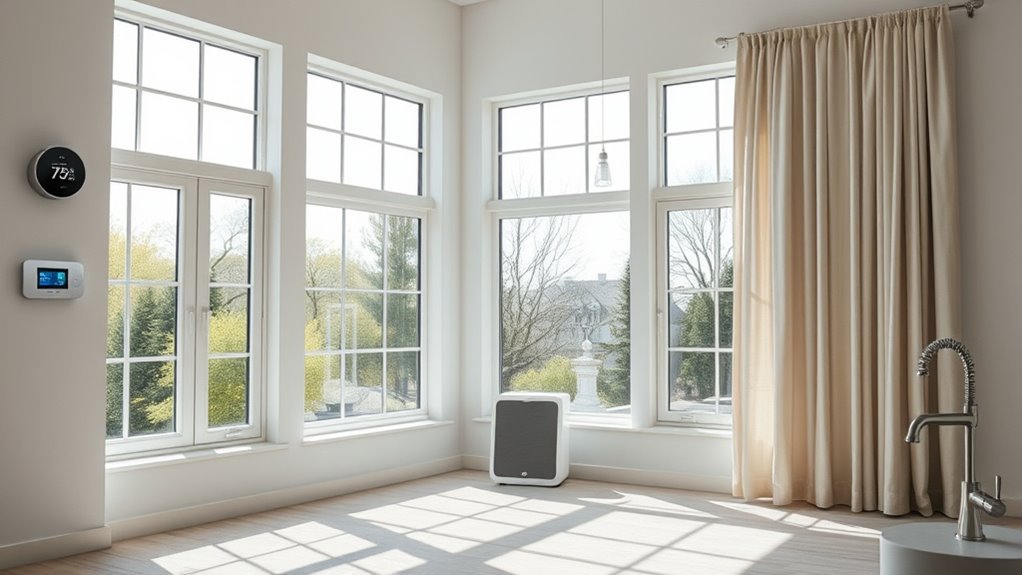Investing in solar water systems and smart thermostats can pay for themselves over time by reducing your energy bills and boosting efficiency. Solar water heaters harness sunlight to cut down on electric or gas costs, while smart thermostats optimize your heating and cooling for maximum savings. Together, they make your home eco-friendlier and more cost-effective. To discover how these upgrades can work for your home and save you money, keep exploring the options available.
Key Takeaways
- Installing solar water systems reduces utility bills and offers long-term savings with minimal maintenance.
- Upgrading to a smart thermostat optimizes heating and cooling, preventing energy waste and lowering costs.
- Combining solar water heaters with smart thermostats maximizes energy efficiency and accelerates return on investment.
- Taking advantage of utility rebates and incentives can offset installation costs of energy-efficient upgrades.
- These upgrades enhance home value, appeal to eco-conscious buyers, and support sustainable living efforts.

Upgrading your home for energy efficiency can markedly reduce utility bills and environmental impact. One of the most effective ways to do this is by installing solar water systems. Solar water heaters harness the sun’s energy to heat your water, considerably cutting down on energy consumption from traditional electric or gas water heaters. These systems typically include solar collectors and a storage tank, and once installed, they require minimal maintenance. By using free solar power, you’ll notice lower monthly bills, and over time, the savings will offset the initial investment. Plus, solar water systems are durable and environmentally friendly, making them a smart choice for sustainable living.
Installing solar water heaters reduces energy costs and environmental impact with minimal maintenance.
Another essential upgrade is installing smart thermostats. These devices give you precise control over your home’s heating and cooling, allowing you to optimize comfort while reducing unnecessary energy use. With a smart thermostat, you can program your heating and cooling schedules to match your daily routine, ensuring you’re not wasting energy when you’re away or asleep. Many models learn your preferences over time, adjusting settings automatically for maximum efficiency. Some smart thermostats even enable remote control via smartphone apps, so you can adjust your home’s temperature from anywhere. This flexibility prevents energy waste and can lead to substantial savings on your utility bills.
Combining solar water systems with smart thermostats creates a powerful synergy for energy efficiency. For instance, you can set your smart thermostat to lower the temperature when you’re away or asleep, reducing heating or cooling costs. Meanwhile, your solar water heater continues to provide hot water efficiently, further decreasing reliance on grid electricity. This integrated approach not only saves money but also minimizes your carbon footprint by reducing fossil fuel consumption.
Implementing these upgrades is straightforward and often cost-effective. Many utility companies offer rebates or incentives for installing solar water systems and smart thermostats, making the upfront costs more manageable. Additionally, upgrading your home with these technologies can increase its overall value and appeal to future buyers who are environmentally conscious. Research shows that AI-powered analytics can help optimize energy consumption patterns, further enhancing savings. Over time, you’ll enjoy lower utility bills, a smaller environmental impact, and enhanced comfort in your home.
Frequently Asked Questions
What Are the Most Cost-Effective Upgrades for Small Homes?
You should focus on cost-effective upgrades like installing solar panels and smart thermostats. Solar panels can markedly cut your electricity bills, often paying for themselves over time. Smart thermostats help you manage heating and cooling more efficiently, reducing energy waste. These upgrades are affordable for small homes and provide quick returns, making them smart choices to improve your home’s energy efficiency without breaking the bank.
How Long Does It Typically Take to Recoup Upgrade Costs?
Think of your upgrades as planting seeds that grow into savings. Typically, solar panel installation recoups costs in 6-10 years, depending on energy use and incentives. A smart thermostat benefits you immediately by reducing energy bills and improving comfort, often paying for itself in less than two years. With these upgrades, you’re cultivating a future where your home becomes more efficient and your expenses shrink over time.
Are There Government Incentives for Energy-Efficient Improvements?
You’ll find that government rebates and tax incentives can substantially reduce your upfront costs for energy-efficient upgrades. Many programs offer rebates for installing solar panels, upgrading insulation, or switching to energy-efficient windows. By taking advantage of these incentives, you can lower your investment, making it easier to recoup your costs faster. Check with local and federal agencies to see what rebates and tax incentives are available in your area.
Can These Upgrades Increase My Home’s Resale Value?
Did you know homes with energy-efficient features sell for 5-10% more? Upgrading with smart thermostats and solar panels can boost your home’s resale value. Buyers appreciate lower utility bills and eco-friendly features, making your home more attractive. These upgrades not only save you money but can also give your property a competitive edge in the market, potentially leading to a quicker sale and higher offers.
What Maintenance Is Required for Energy-Efficient Systems?
You should follow a maintenance checklist to keep your energy-efficient systems running smoothly. Regularly change filters, inspect ducts, and clean components as recommended by manufacturers. This helps extend the system lifespan and guarantees peak performance. Scheduling annual tune-ups and addressing minor issues promptly can prevent costly repairs. Staying on top of maintenance keeps your systems efficient, saving you money on energy bills and prolonging their effectiveness over time.
Conclusion
Imagine stepping into your home, where sunlight streams through new energy-efficient windows, warming each room with a gentle glow. The quiet hum of your upgraded appliances runs smoothly, saving you money and reducing your carbon footprint. As you relax in this cozy, cost-effective space, you realize these upgrades aren’t just improvements—they’re investments in a brighter, more sustainable future. With every smart change, your home becomes a sanctuary that pays you back, day after day.










